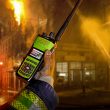First-responder survey generates a few surprises
A recent survey of 200 public safety communications officials and responders conducted by Motorola—in conjunction with the Association of Public-Safety Communications Officials (APCO)—indicated they were much more concerned about their ability to respond to natural disasters than to terrorist attacks or crime. This was just one of several surprises revealed by the survey.
Of those interviewed, 65% identified response to natural disasters as a top concern, compared with terrorist attacks (7%) and crime (10%). While surprised by the finding, Richard Mirgon, an APCO first vice president and the director of technology for Douglas County, Nev., said he understands why, believing that attitudes have changed in part because more than six years have passed since 9/11 and because many regions of the country have endured mega-disasters—including Hurricane Katrina in 2006 and the California wildfires in 2003 and last year—during the same period.
“I think the feeling across America is that a natural disaster can have a more significant impact on loss of life, damage to property and impact on our economy than a single terrorist attack can,” Mirgon said in an interview with MRT. “There’s a tendency to focus on recent events and build a little complacency.
But Mirgon also believes that this finding signals an important long-term change in the way the first-responder community thinks about its communications needs.
“Trends change over time and, if there was another terrorist event, those numbers would move some,” he said. “But I’m not too sure they’d move a lot, simply because, when you look at Katrina, the amount of damage it caused—[Hurricane] Andrew, the Northridge earthquake in California—there have been a lot of natural disasters that have had a lot of impact.”
Another surprise found in the survey results concerns how those who procure public safety communications systems and equipment view technology versus how first responders in the field view it, according to Tom Quirke, Motorola’s director of product marketing. For example, 24% of the first responders who were interviewed identified ease of use as an important criterion for any new technology; in contrast, only 1% of public administrators thought ease of use to be important.
“[First responders are] very comfortable with the voice systems they have today—they’re built over generations. The ergonomics, the usage—you don’t need to look at a radio to be able to use it,” Quirke said in an interview with MRT. “But first responders clearly said that any new technology has to be easy to use.”
Quirke believes procurement officials “who are making decisions about new technology and when to bring it in,” should take note of the “really big difference” in opinion on this topic before pulling the trigger.
“From the perspective of public administrators, they really need to get closer to the first responders before making any decisions on public-safety equipment. … This is potentially a big wake-up call because it could lead to a lot of rollouts of new equipment and new technology that are inappropriate,” Quirke said. “[First responders] told us, quite honestly, that if equipment gets in the way, they’re not going to use it.”
One aspect of the survey that wasn’t surprising was that public safety still ranks interoperability high on the wish list. Quirke said interviewees generally noted the improvement that has been made over the past few years but clearly indicated that more improvement is needed.
“They said, ‘Well done, but you still have a lot more work to do.’ That’s a fair comment,” he said. “We’re working towards that full level of interoperability, but they have a lot more solutions than they had five years ago.”
Quirke added that survey respondents also expressed interest in device-level interoperability.
“That’s interesting. They have network interoperability—a number of vendors, and we’re one of them, have gateways that connect through, and then we have the standards within P25 that allow interoperability. But they also want to know what they can do at the device level, so all they have to do is turn a switch.”

















